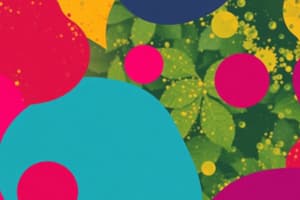Podcast
Questions and Answers
[Blank] and references are essential in scholarly sources as they allow for verification of the information presented.
[Blank] and references are essential in scholarly sources as they allow for verification of the information presented.
Citations
When evaluating online sources, assessing the ______ involves determining whether the information is presented without bias.
When evaluating online sources, assessing the ______ involves determining whether the information is presented without bias.
objectivity
[Blank] journals are valuable academic resources because their content has been assessed by experts ensuring quality and validity.
[Blank] journals are valuable academic resources because their content has been assessed by experts ensuring quality and validity.
Academic
For in-depth research often funded by governments, ______ reports are a reliable source of scholarly information.
For in-depth research often funded by governments, ______ reports are a reliable source of scholarly information.
To locate theses and dissertations online, one can utilize databases such as Proquest and ______.
To locate theses and dissertations online, one can utilize databases such as Proquest and ______.
The Internet is a global network of interconnected computers and other devices that use standardized protocols such as ______ to communicate.
The Internet is a global network of interconnected computers and other devices that use standardized protocols such as ______ to communicate.
The World Wide Web is a service that operates over the Internet, providing access to interlinked documents and multimedia resources, which are accessed using web ______.
The World Wide Web is a service that operates over the Internet, providing access to interlinked documents and multimedia resources, which are accessed using web ______.
Web pages are documents formatted in ______ that can contain text, images, videos, and other multimedia elements.
Web pages are documents formatted in ______ that can contain text, images, videos, and other multimedia elements.
The protocol used for transferring web pages securely, which includes SSL/TLS encryption, is known as ______.
The protocol used for transferring web pages securely, which includes SSL/TLS encryption, is known as ______.
One key difference between the Internet and the WWW is that the Internet encompasses the entire global network and all services, while the WWW is a ______ that operates on the Internet.
One key difference between the Internet and the WWW is that the Internet encompasses the entire global network and all services, while the WWW is a ______ that operates on the Internet.
Besides the web, the Internet also facilitates various forms of digital communication such as email, file transfer, and ______ access.
Besides the web, the Internet also facilitates various forms of digital communication such as email, file transfer, and ______ access.
The hardware components of the Internet include physical elements like computers, servers, routers, cables, and even ______.
The hardware components of the Internet include physical elements like computers, servers, routers, cables, and even ______.
URLs, or Uniform Resource Locators, are used to identify resources on the web and are essential for ______ and retrieving specific web pages or files.
URLs, or Uniform Resource Locators, are used to identify resources on the web and are essential for ______ and retrieving specific web pages or files.
The World Wide Web primarily utilizes ______ for transferring web pages and related website content.
The World Wide Web primarily utilizes ______ for transferring web pages and related website content.
Search engines employ automated programs known as ______ or spiders to explore the web, discovering new or updated web pages.
Search engines employ automated programs known as ______ or spiders to explore the web, discovering new or updated web pages.
The ranking of indexed pages in search engine results is determined by complex ______ that consider factors such as keyword usage, page quality, and user engagement.
The ranking of indexed pages in search engine results is determined by complex ______ that consider factors such as keyword usage, page quality, and user engagement.
[Blank] search engines like Dogpile aggregate results from multiple search engines into one, providing a broader overview of available information.
[Blank] search engines like Dogpile aggregate results from multiple search engines into one, providing a broader overview of available information.
Unlike non-scholarly sources, scholarly information is characterized by ______ with respect to the levels of accuracy, reliability and objectivity.
Unlike non-scholarly sources, scholarly information is characterized by ______ with respect to the levels of accuracy, reliability and objectivity.
The massive database where search engines store information gathered by crawlers is called an ______.
The massive database where search engines store information gathered by crawlers is called an ______.
A key characteristic of scholarly information is that the ______ and affiliations of the authors are usually provided, indicating their expertise.
A key characteristic of scholarly information is that the ______ and affiliations of the authors are usually provided, indicating their expertise.
[Blank] information is reviewed by experts in a particular field of study.
[Blank] information is reviewed by experts in a particular field of study.
Flashcards
The Internet
The Internet
A global network of interconnected computers using TCP/IP.
Internet Hardware
Internet Hardware
Physical parts; computers, servers, routers, cables, and satellites.
Internet Protocols
Internet Protocols
Standardized rules for devices to communicate, like TCP/IP.
Internet Services
Internet Services
Signup and view all the flashcards
World Wide Web (WWW)
World Wide Web (WWW)
Signup and view all the flashcards
Web Pages
Web Pages
Signup and view all the flashcards
Web Browsers
Web Browsers
Signup and view all the flashcards
Web Servers
Web Servers
Signup and view all the flashcards
Peer Reviewed
Peer Reviewed
Signup and view all the flashcards
Scholarly Publishers
Scholarly Publishers
Signup and view all the flashcards
Scholarly Sources
Scholarly Sources
Signup and view all the flashcards
Scholarly Information Online
Scholarly Information Online
Signup and view all the flashcards
Evaluating Online Sources Criteria
Evaluating Online Sources Criteria
Signup and view all the flashcards
WWW
WWW
Signup and view all the flashcards
Internet
Internet
Signup and view all the flashcards
WWW Protocols
WWW Protocols
Signup and view all the flashcards
Search Engines
Search Engines
Signup and view all the flashcards
Crawlers/Spiders
Crawlers/Spiders
Signup and view all the flashcards
Search Engine Index
Search Engine Index
Signup and view all the flashcards
Search Engine Ranking
Search Engine Ranking
Signup and view all the flashcards
Scholarly Information
Scholarly Information
Signup and view all the flashcards
Study Notes
- Scholarly and Academic Information Online, by Dr. A. Ateka
Learning Objectives
- Explain what constitutes scholarly and academic information
- Identify and locate scholarly sources online
- Acquire basic criteria for evaluating information sources
Important Questions
- What is the Internet?
- How is it different from the WWW?
- What percentage of the Internet is visible and indexed by search engines?
- What is a search engine?
- What are scholarly and academic information sources?
- How do they differ from popular sources?
The Internet
- Defined in 1960 as a global network of interconnected computers and other devices.
- The internet allows communication using standardized protocols (TCP/IP) and is the infrastructure that allows various types of digital communication to occur.
- Hardware components include computers, servers, routers, cables, and satellites.
- Protocols are standardized rules that devices use to communicate, most important ones are TCP (Transmission Control Protocol) and IP (Internet Protocol).
- Services and applications include email, file transfer (FTP), online gaming, streaming, and the World Wide Web.
The World Wide Web (WWW)
- Defined in 1989 as a service operating over the Internet
- Provides access to a vast array of interlinked documents and multimedia resources.
- These resources are accessed using web browsers and identified through URLs (Uniform Resource Locators).
- Web Pages are documents formatted in HTML (Hypertext Markup Language) that contain text, images, videos.
- Web Browsers: Software applications like Google Chrome, Mozilla Firefox, and Safari that retrieve, interpret, and display web pages.
- Web Servers: Computers that store and serve web pages to users over the Internet.
- HTTP/HTTPS: Protocols are used for transferring web pages
- HTTP is Hypertext Transfer Protocol
- HTTPS is its secure version, using SSL/TLS encryption.
Key Differences Between the Internet and the WWW
- Internet encompasses the entire global network of interconnected devices and all services operating over this network.
- WWW is a specific service that operates on the Internet, enabling access to interlinked web pages and multimedia content.
- The internet facilitates various forms of digital communication, including email, file transfer, and remote access, in addition to the web.
- WWW is specifically focused on accessing and sharing web pages and multimedia content via web browsers.
- Internet Uses a variety of protocols, including TCP/IP, SMTP (for email), FTP (for file transfers)
- WWW primarily uses HTTP/HTTPS for transferring web pages and web-related content.
- Internet provides the backbone for a wide range of online activities and services.
- WWW is used for browsing and accessing information and resources through web pages.
Search Engines
- These are powerful tools that help users find information on the Internet.
- They index web pages and returning relevant results based on user queries
How Search Engines Work
- Crawling occurs when search engines uses automated programs called crawlers or spiders to browse the web and discover new or updated web pages.
- These crawlers follow links from one page to another, collecting data about the content of each page.
- Indexing occurs when data gathered by crawlers is stored in a massive database known as an index.
- The index contains a copy of each web page's content, metadata, and other relevant information that helps determine the page's relevance to different search queries.
- During Ranking, the search engine uses complex algorithms to rank the indexed pages based on their relevance to the query a user submits.
- Factors influencing ranking include keyword usage, page quality, relevance,user engagement, and backlinks.
- Results Display: the search engine presents the user with a list of ranked results, typically on a search engine results page (SERP).
- Results often include snippets, titles, URLs, and sometimes additional information like images, videos, or rich snippets.
Types of Search Engines:
- General search engines include Google, Bing, and DuckDuckGo.
- Academic search engines include Google Scholar and Pubmed
- Specialized search engines include Wolfram Alpha, Yandex, and Archive.org
- Metasearch Engines include Dogpile, Excite, Search.com and Webcrawler
Scholarly Information
- A scholarly information source is a resource that has been written and reviewed by experts in a particular field of study.
- These are characterized by rigor regarding their levels of accuracy, reliability and objectivity.
- Non-scholarly sources are not necessarily authored by experts.
- Often non-scholarly sources have no peer review and may lack objectivity, evidence of research and also lack references/citations.
- Examples are newspapers, magazines, and blogs.
Characteristics of Scholarly Information:
- Authorship involves experts, credentials and affiliations are provided.
- Peer review involves other experts review to ensure quality and validity
- Citations and references are provided for verification
- Publishers are Academic institutions, professional organizations, and reputable academic publishers
- The language and structure is appropriate for the field
- The target Audience is researchers, scholars, and students in the field of study
Types of Scholarly and Academic Sources:
- Academic journals
- Books and monographs
- Theses and dissertations
- Conference papers
- Research reports – in-depth and often funded by governments
- Research data and data sets
Where to find Scholarly Information Online:
- University repositories for theses and other scholarly works
- Open Access Resources like the Directory of Open Access Journals (DOAJ); DOAB; CORE
- University Libraries – USIU- Africa Library
- Data repositories like Dryad, Zenodo, and Figshare
- Conference websites – ACM, IEEE,
- Educational videos and lectures like Moocs such as Khan Academy, Cousera, and YouTube
- Theses and Dissertation databases like Proquest and Ethos
- Government and Institutional Repositories – NIH, European Union
- Academic Networks and Social Media – LinkedIn, ResearchGate, and Academia.edu
- Specialized academic search engines such as Google Scholar, Microsoft Academic, and BASE.
Evaluating Online Sources:
- Authority – determining who is the author
- Accuracy – determine if the information supported by evidence
- Objectivity – Is the information presented without bias?
- Currency - is it up-to-date?
- Coverage - does it cover the topic comprehensively?
Studying That Suits You
Use AI to generate personalized quizzes and flashcards to suit your learning preferences.




